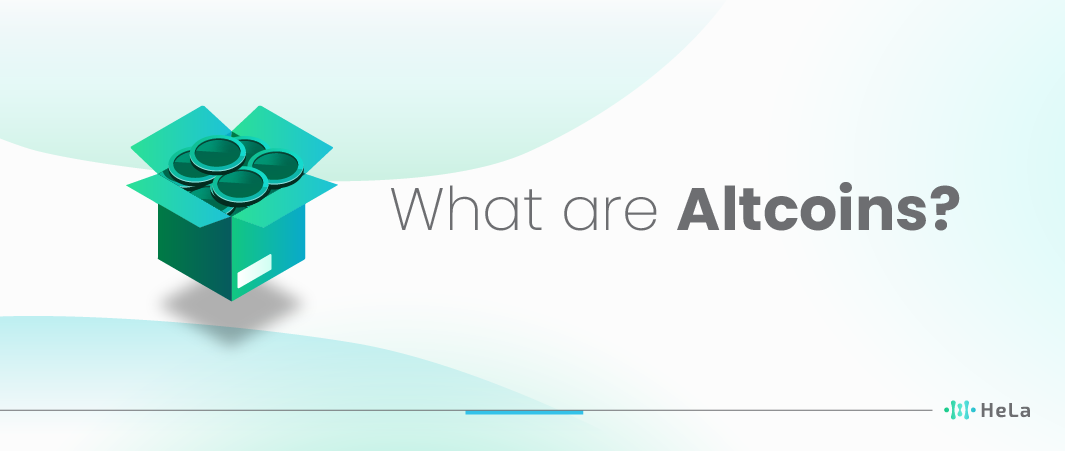In the dynamic world of cryptocurrencies, Bitcoin has long reigned supreme as the undisputed leader. However, the crypto landscape is far from a one-trick pony. A diverse array of alternative digital currencies, collectively known as altcoins, has emerged to challenge Bitcoin’s dominance and reshape the financial landscape. If you’ve ever wondered, “what are altcoins?” and contemplated their significance, this comprehensive guide will unravel the mysteries of altcoins, equipping you with a clear understanding of their unique characteristics, their role in the cryptocurrency market, and their potential impact on the global financial landscape.
Altcoins, which stands for “alternative coins,” are a broad category of digital currencies that emerged following the success of Bitcoin. These altcoins, often considered “challenger coins,” aim to address perceived limitations of Bitcoin or introduce innovative features that could revolutionize the world of finance. While some altcoins have gained significant traction, others have faded into obscurity, highlighting the volatile and unpredictable nature of the cryptocurrency market. Nevertheless, the collective existence of altcoins has democratized the cryptocurrency space, fostering a vibrant ecosystem of innovation and experimentation.
As we delve deeper into the world of altcoins, it’s crucial to recognize that they are not merely imitations of Bitcoin. Each altcoin possesses unique characteristics, often tailored to specific use cases or industries. Some altcoins focus on enhancing transaction speed, while others prioritize privacy or scalability. Additionally, some altcoins have ventured beyond the realm of pure currency, integrating with blockchain technology to power decentralized applications (dApps) and smart contracts. This diversification within the altcoin ecosystem underscores the vast potential of blockchain technology to transform various aspects of our financial world.
What Are Altcoins?
In the realm of cryptocurrencies, Bitcoin reigns supreme as the first and most widely recognized digital currency. However, Bitcoin is not the only player in this ever-evolving landscape. Altcoins, short for “alternative coins,” have emerged as a diverse and dynamic group of digital assets, each with its own unique characteristics and potential applications.
Also Read: Hela Stablecoin (HLUSD): Unveiling the Future of Stability in Cryptocurrency
To understand what altcoins are, it’s important to first define Bitcoin. Bitcoin is a decentralized peer-to-peer electronic cash system. This means that it operates without the need for intermediaries like banks or governments. Instead, transactions are verified and recorded on a distributed ledger called a blockchain, which is a publicly accessible record of all transactions.
Altcoins, on the other hand, are any cryptocurrency that is not Bitcoin. They built upon the foundation established by Bitcoin, offering innovative features and addressing perceived limitations of their predecessor. Some altcoins aim to improve scalability, transaction speed, or anonymity, while others focus on specific use cases, such as decentralized applications or supply chain management.
Categories of Altcoins

Altcoins, also known as alternative cryptocurrencies, are any cryptocurrency other than Bitcoin. They represent a diverse range of digital assets with varying functionalities, purposes, and underlying technologies. To better understand the altcoin landscape, it’s helpful to categorize them based on their shared characteristics and goals. These categories include:
Forked Coins
These altcoins are derived from Bitcoin’s source code with modifications to enhance certain features. Examples include Bitcoin Cash (BCH) and Bitcoin SV (BSV).
Smart Contract Platforms
Ethereum (ETH) pioneered the concept of smart contracts, allowing developers to create decentralized applications (DApps) on its blockchain. Other platforms like Binance Smart Chain (BNB) and Cardano (ADA) have followed suit.
Payment Cryptocurrencies
These altcoins aim to serve as mediums of exchange for goods and services, similar to traditional fiat currencies. They often prioritize fast transaction speeds, low fees, and widespread adoption. Examples include Litecoin (LTC), Ethereum Classic (ETC), and Zcash (ZEC).
Utility Tokens
These altcoins provide specific functionalities within a particular decentralized application (DApp) or ecosystem. They are often used to access services, pay for transactions, or participate in governance. Examples include LINK (Chainlink), BAT (Basic Attention Token), and BNB (Binance Coin).
Stablecoins
These altcoins are designed to maintain a stable price, typically pegged to a fiat currency or a commodity like gold. They aim to mitigate the volatility that often plagues cryptocurrencies, making them more suitable for everyday transactions. Examples include Tether (USDT), USD Coin (USDC), and Dai (DAI).
Governance Tokens
These altcoins grant holders voting rights within a decentralized governance structure. They allow users to participate in decision-making processes, such as protocol upgrades or treasury management. Examples include Aave (AAVE), Uniswap (UNI), and Compound (COMP).
Security Tokens
These altcoins represent ownership or fractional ownership in real-world assets, such as securities, real estate, or commodities. They aim to bridge the gap between traditional financial instruments and the blockchain. Examples include tBTC (Tokenized Bitcoin), Security Token Issuance Facility (STIF), and Harbor (RHBT).
Privacy Coins
These altcoins prioritize user privacy and transaction anonymity. They employ cryptographic techniques to obfuscate transaction details and protect user identities. Examples include Monero (XMR), Zcash (ZEC), and Verge (XVG).
Meme Coins
These altcoins often gain popularity through social media trends or humorous narratives. They may not have a specific use case or underlying technology but can experience significant price fluctuations due to hype and speculation. Examples include Dogecoin (DOGE), Shiba Inu (SHIB), and Floki Inu (FLOKI).
It’s important to note that these categories are not mutually exclusive. Some altcoins may fall into multiple categories, and the landscape is constantly evolving with new innovations and emerging use cases. Thorough research and due diligence are essential before investing in any altcoin.
The Role of Altcoins

Altcoins, short for alternative coins, play a significant role in the cryptocurrency ecosystem. They are essentially any digital currency other than Bitcoin, which was the first and remains the most well-known cryptocurrency. Altcoins have gained prominence for several reasons, and their role in the world of digital finance is multifaceted. Here’s a more detailed look at the role of altcoins:
Diversification
Altcoins provide investors and users with a way to diversify their cryptocurrency holdings. Diversification can help spread risk and reduce exposure to the potential volatility of a single cryptocurrency like Bitcoin. By investing in a variety of altcoins, users can hedge their bets and potentially benefit from the performance of different projects.
Technological Innovation
Many altcoins are designed to improve upon Bitcoin’s technology and offer unique features or functions. For example, Ethereum introduced the concept of smart contracts, which enabled programmable, self-executing agreements. Other altcoins have focused on privacy, scalability, or energy efficiency, pushing the boundaries of what’s possible in the blockchain and cryptocurrency space.
Use Cases
Altcoins often cater to specific use cases or industries. For instance, Ripple (XRP) was created to facilitate cross-border payments for financial institutions, while Chainlink (LINK) focuses on connecting smart contracts with real-world data. These altcoins are tailored to address particular challenges and opportunities in their respective sectors.
Market Competition
Altcoins create competition in the cryptocurrency market, pushing projects to innovate and improve their technology, security, and user experience. Competition can lead to a healthier ecosystem, with the best projects rising to the top and gaining wider adoption.
Investment and Speculation
Altcoins provide opportunities for traders and investors to speculate on price movements. The high volatility in the altcoin market can offer potentially significant returns for those who can accurately anticipate market trends. However, this speculation also brings increased risk, and it’s important for investors to conduct thorough research before investing.
Tokenization
Altcoins can represent ownership or access rights to various assets beyond traditional cryptocurrencies. Tokenization involves converting real-world assets like real estate, art, or company stocks into digital tokens on blockchain networks. Altcoins are often used as tokens for these purposes, enabling fractional ownership and easier transfer of these assets.
Community and Development
Altcoins foster diverse communities of developers, users, and supporters. These communities contribute to the growth and development of their respective projects, creating a decentralized and collaborative approach to innovation in the crypto space.
Decentralization
Some altcoins aim to be more decentralized than Bitcoin, which has faced concerns related to mining centralization. Projects like Litecoin and Decred have implemented different consensus mechanisms and mining algorithms to promote greater decentralization.
Global Financial Inclusion
Altcoins can play a role in providing financial services to underserved populations around the world, especially in regions with limited access to traditional banking. They offer opportunities for peer-to-peer transactions and financial inclusion, where individuals can have control over their funds and access to the global economy.
It’s important to note that the altcoin market is highly speculative and can be prone to scams and fraudulent projects. As with any investment, due diligence is crucial when considering the role of altcoins in your financial strategy. The cryptocurrency landscape is constantly evolving, and the role of altcoins continues to adapt and expand as new projects and technologies emerge.
The Potential Impact of Altcoins
The rise of altcoins has the potential to reshape the financial landscape in several ways:
Competition and Innovation
Altcoins challenge Bitcoin’s dominance, driving innovation and improvement in the cryptocurrency space. This competition can lead to more efficient, scalable, and user-friendly blockchain technologies. For example, Bitcoin’s dominance has pushed developers to explore solutions to its scalability issues, resulting in the development of layer-2 solutions like the Lightning Network.
Similarly, altcoins often experiment with consensus algorithms, governance structures, and transaction speeds, pushing the entire cryptocurrency ecosystem to evolve and adapt to meet the demands of users and businesses.
Use Cases Beyond Currency
Altcoins often introduce novel use cases for blockchain technology. Ethereum’s smart contracts, for instance, have opened up a world of possibilities for decentralized applications. These smart contracts enable self-executing agreements with the terms of the contract directly written into code.
This innovation has given rise to various decentralized applications, including decentralized finance (DeFi) platforms, which provide services like lending, borrowing, and trading without intermediaries. Additionally, altcoins have driven the emergence of non-fungible tokens (NFTs), which are unique digital assets with applications in art, gaming, collectibles, and beyond. The proliferation of altcoins continues to expand the horizons of blockchain technology, with each new project introducing its unique features and applications.
Financial Inclusion
Altcoins may extend financial services to underserved populations, providing an accessible and affordable means of conducting transactions, saving, and investing. Cryptocurrencies can be particularly beneficial in regions with limited access to traditional banking services. By using altcoins, individuals can gain access to a global financial system, which doesn’t rely on traditional intermediaries.
This opens up opportunities for cross-border remittances, microfinance, and peer-to-peer lending, among other financial services. Moreover, altcoins can offer stability in areas with volatile local currencies, as people can store their wealth in cryptocurrencies, providing a measure of protection against inflation and economic instability.
Risks and Considerations

Altcoins can be quite enticing, offering potential opportunities for investors, but it’s vital to be aware of the associated risks. To start, let’s clarify what altcoins are – they’re basically alternative cryptocurrencies to Bitcoin. But here’s the catch: the crypto market is like a rollercoaster, incredibly speculative and unpredictable. Not all altcoins will make it big; some might stumble due to low user adoption, security issues, or regulatory hurdles.
Also Read: What is Wrapped Tokens? Purpose and Functionality
Before diving in, it’s wise to roll up your sleeves and do some serious homework. Get to know the tech behind these altcoins, evaluate the credibility of the project’s team, and assess the fundamentals of the project. And when it comes to investing, diversifying your portfolio is a good idea, but be cautious about it.
Know the ropes and potential pitfalls before you spread your funds around. Remember, what are altcoins without understanding the game? The crypto world can be thrilling, but it’s like the Wild West, and you need to tread carefully.
Conclusion
In a nutshell, altcoins play a crucial role in the world of cryptocurrencies. To put it simply, altcoins are digital assets beyond the well-known Bitcoin. They offer a wide variety of unique features and uses. So, what are altcoins, exactly? Altcoins are basically any cryptocurrency that isn’t Bitcoin.
Their presence is vital for anyone interested in crypto, whether you’re an enthusiast or an investor. As the crypto landscape continues to evolve, altcoins are at the forefront, driving innovation and pushing the boundaries of blockchain technology.
However, it’s important to approach altcoins with a degree of caution. The world of digital currencies is complex and ever-changing. Therefore, thorough research and careful consideration are crucial when exploring the vast array of altcoins available. So, remember, while altcoins offer exciting opportunities, a solid understanding and due diligence are your best allies when navigating this dynamic market.
Disclaimer: The information provided by HeLa Labs in this article is intended for general informational purposes and does not reflect the company’s opinion. It is not intended as investment advice or recommendations. Readers are strongly advised to conduct their own thorough research and consult with a qualified financial advisor before making any financial decisions.

I am Carina Caringal, a technical writer specializing in blockchain engineering concepts, decentralized systems, crypto infrastructure, and Web3 technologies. My work focuses on analyzing and translating complex technical mechanisms into precise, structured, and insightful content for both developers and non-technical readers who want a deeper understanding of the decentralized ecosystem.
My background in blockchain and cryptocurrency is rooted in years of independent research, continuous learning, and hands-on exploration across multiple protocols and network architectures. I study the underlying mechanics of distributed ledger technology, from consensus algorithms and smart contract logic to network scalability, security models, cryptographic principles, and interoperability frameworks. This technical foundation shapes the way I approach every article, ensuring accuracy, depth, and relevance.
- Carina Caringalhttps://helalabs.com/blog/author/carina-caringal/
- Carina Caringalhttps://helalabs.com/blog/author/carina-caringal/
- Carina Caringalhttps://helalabs.com/blog/author/carina-caringal/
- Carina Caringalhttps://helalabs.com/blog/author/carina-caringal/

